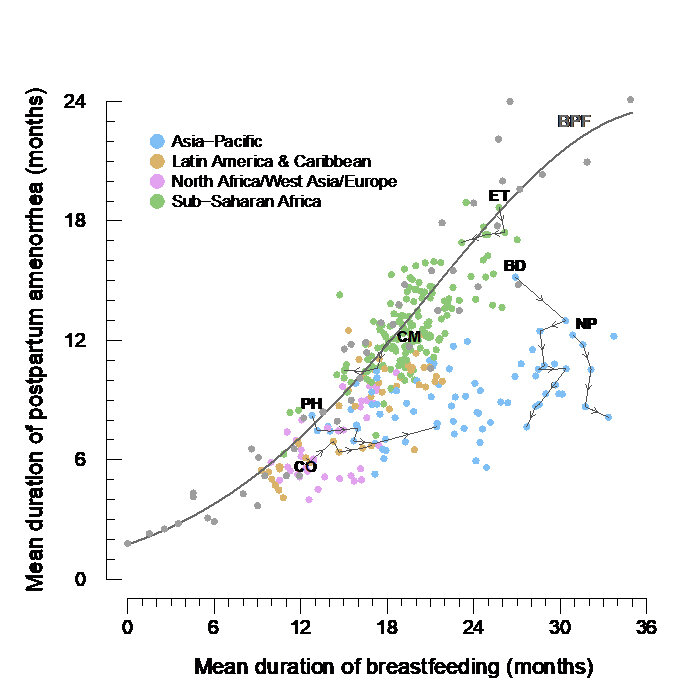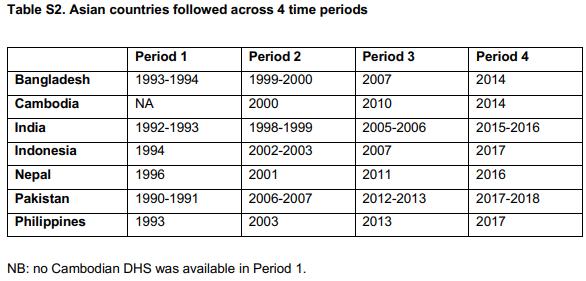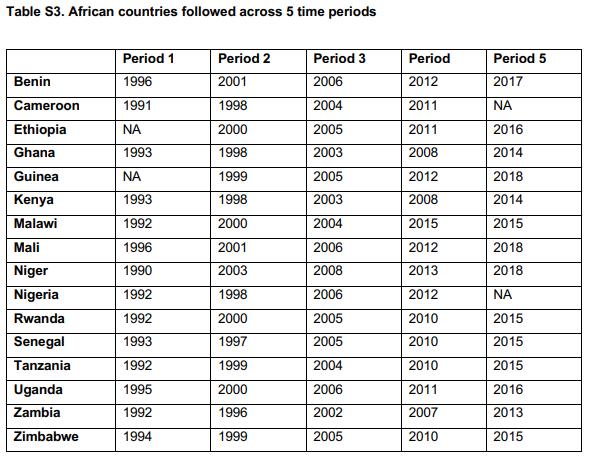母乳喂养的避孕效果随社会经济发展而降低
诸平

Fig. 1 Relationship between average breastfeeding duration (x-axis) and average amenorrhoea (y-axis). Each point represents one survey analysed as part of the study. The "trajectory" of countries through successive surveys may be followed: in Bangladesh (BD), for example, duration of breastfeeding has remained stable, but that of postpartum amenorrhoea has decreased significantly since 1975. Credit: Todd et al./PNAS. The contraceptive effect of breastfeeding decreases with socio-economic development by CNRS


据法国国家科学研究中心(CNRS)2021年7月20日提供的消息,母乳喂养的避孕效果随社会经济发展而降低,相关研究结果于2021年7月20日已经在美国《国家科学院院刊》(Proceedings of the National Academy of Sciences)发表——Nicolas Todd, Mathias Lerch. Socioeconomic development predicts a weaker contraceptive effect of breastfeeding. Proceedings of the National Academy of Sciences, July 20, 2021; 118 (29): e2025348118. DOI: 10.1073/pnas.2025348118. https://doi.org/10.1073/pnas.2025348118. (原文详见:e2025348118.full.pdf)参与此项研究的除了德国马克斯·普朗克人口研究所(Max Planck Institute for Demographic Research)的研究人员之外,还有来自法国巴黎的索邦大学(Sorbonne Université, 75005 Paris, France)以及瑞士洛桑联邦理工大学(Ecole Polytechnique Fédérale de Lausanne)的研究人员。
图1表示平均母乳喂养时间(x轴)与平均闭经时间(y轴)的关系。每个点代表作为研究一部分分析的一项调查。通过连续的调查,各国的“轨迹”可以遵循如下:例如,在孟加拉国(Bangladesh简称BD),母乳喂养的时间保持稳定,但产后闭经的时间自1975年以来显著减少。
对于不母乳喂养的女性来说,分娩后的暂时不孕症平均只持续几周,而对于母乳喂养的女性来说,可以持续几个月,甚至一年以上。但目前还不清楚母乳喂养的避孕效果是如何受到母亲的“精力状况”(包括营养状况和体力活动水平)的影响的。
德国马克斯·普朗克人口研究所(Max Planck Institute for Demographic Research)和法国国家科学研究中心(CNRS)的研究人员刚刚首次在全球范围内表明,母乳喂养对卵巢功能的影响高度依赖于环境条件。https://medicalxpress.com/tags/developing+countries/
科学家们分析了84个发展中国家(developing countries)过去45年的270万新生儿,发现母乳喂养时间与产后闭经的平均时间(分娩后没有月经,而最明显的卵巢功能抑制迹象)比20世纪60-70年代观察到的要弱得多。这表明,近年来,在这84个国家中,母乳喂养的避孕效果明显下降。
该下降也直接在研究期间(1975-2019年)观察到。此外,人类发展指数的高值或通电等特点与母乳喂养的避孕效果减少有关。这意味着在同样的母乳喂养时间内,国家越发达,分娩后的暂时不孕症越低。这些结果证实了近几十年来生殖生态学专家进行的实地研究的结果。
它们也在呼吁人口统计学家放弃在生育研究中可以忽略环境条件(environmental conditions)的观念。上述介绍仅供参考,欲了解更多信息敬请注意浏览原文(e2025348118.full.pdf)或者相关报道。
Oral contraceptives lower ovarian cancer risk in BRCA carriers
Breastfeeding suppresses postpartum fecundity (the capacity for reproduction). This mechanism is critically important to control fertility (actual reproduction) when contraception is uncommon. Whether dependence of the contraceptive effect of breastfeeding on environmental conditions is strong enough to have a significant effect on fertility remains unclear. Analyzing 2.7 million births in 84 low- and middle-income countries over the past four decades, we find a dramatic weakening of the breastfeeding–postpartum amenorrhea relationship that correlates with improved living standards. These results suggest that, in the absence of contraception, the effect of breastfeeding on fertility depends on the level of socioeconomic development.
The contraceptive effect of breastfeeding remains essential to controlling fertility in many developing regions of the world. The extent to which this negative effect of breastfeeding on ovarian activity is sensitive to ecological conditions, notably maternal energetic status, has remained controversial. We assess the relationship between breastfeeding duration and postpartum amenorrhea (the absence of menstruation following a birth) in 17 World Fertility Surveys and 284 Demographic Health Surveys conducted between 1975 and 2019 in 84 low- and middle-income countries. We then analyze the resumption of menses in women during unsupplemented lactation. We find that a sharp weakening of the breastfeeding–postpartum amenorrhea relationship has globally occurred over the time period analyzed. The slope of the breastfeeding–postpartum amenorrhea relationship is negatively associated with development: higher values of the Human Development Index, urbanization, access to electricity, easier access to water, and education are predictive of a weaker association between breastfeeding and postpartum amenorrhea. Low parity also predicts shorter postpartum amenorrhea. The association between exclusive breastfeeding and maintenance of amenorrhea in the early postpartum period is also found in rapid decline in Asia and in moderate decline in sub-Saharan Africa. These findings indicate that the effect of breastfeeding on ovarian function is partly mediated by external factors that likely include negative maternal energy balance and support the notion that prolonged breastfeeding significantly helps control fertility only under harsh environmental conditions.
转载本文请联系原作者获取授权,同时请注明本文来自诸平科学网博客。
链接地址:https://m.sciencenet.cn/blog-212210-1296403.html?mobile=1
收藏


